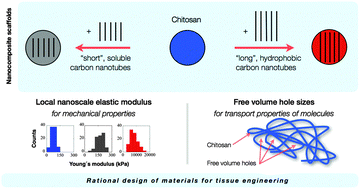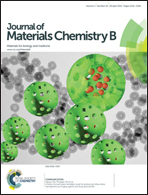Sub-nanoscale free volume and local elastic modulus of chitosan–carbon nanotube biomimetic nanocomposite scaffold-materials
Abstract
Future progress in materials for tissue engineering and 3D cell cultures applications requires control of two key physical properties: nanoscale mechanical properties and mass transport. These requirements remain uncontrolled partly due to a lack of physical parameters and quantitative measurements. Using chitosan scaffolds as a model system in close-to-physiological conditions and a combination of experimental techniques and theory, we link structure with local nanomechanical properties. Additionally we introduce a parameter, the free volume, to predict variations in transport properties. By fabricating nanocomposites with single walled carbon nanotubes (SWNTs) we are able to test our approach: incorporation of acid-treated, soluble, ∼80 nm SWNTs in a chitosan matrix leads to a 2 fold increase in mean local elastic modulus and a decrease of 3% of the free volume available for oxygen diffusion. Inclusion of hydrophobic, ∼800 nm SWNTs leads to a 100 fold increase of elastic modulus and doubles the voids percentage available for the transport of glucose.


 Please wait while we load your content...
Please wait while we load your content...